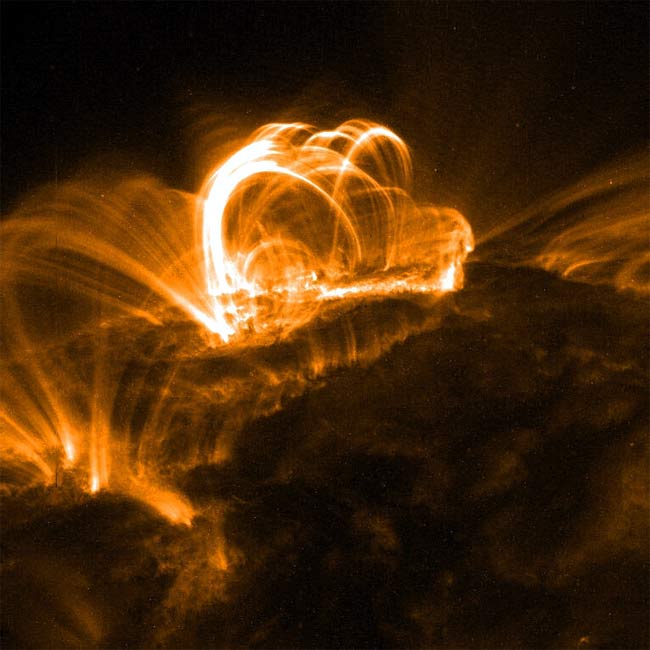Solar Flare Hits Earth and Mars

Powerful radiation bursts from solar flares unleashed by the Sun in 2001 struck Earth and Mars within minutes of each other and affected the upper atmospheres of both planets in similar ways, a new study finds.
The solar flare measurements were made by NASA's Mars Global Surveyor (MGS) spacecraft, which has orbited the red planet since 1999, and by satellites circling Earth.
The finding, detailed in the Feb. 24 issue of the journal Science, could have implications for future Mars missions, since solar flares striking Earth have been known to affect communication and navigation satellites and are often followed by other types of space particle storms that are potentially dangerous for astronauts.
Double bombardments
On April 15, 2001, satellites around Earth recorded the creation of large amounts of electrons and charged particles, called ions, in the planet's ionosphere from ultraviolet radiation and X-rays unleashed by a solar flare. The same thing happened again on April 26.
The ionosphere is the part of a planet's upper atmosphere that absorbs solar radiation.
"The energy of the X-ray photons is so great that once absorbed by the molecule they eject an electron from the atom, leaving an ion behind," explained study member Paul Withers from Boston University.
Breaking space news, the latest updates on rocket launches, skywatching events and more!
During both solar flare events, the MGS spacecraft recorded similar alterations in the Martian ionosphere just minutes after the flares struck Earth.
The finding confirms that solar flare radiation affects the ionospheres of Earth and Mars in similar ways, despite the different chemical compositions of the planets' atmospheres. Earth's ionosphere is populated largely by oxygen and nitrogen, while the Martian ionosphere contains mostly carbon dioxide.
"Since the Martian atmosphere is different in some ways, we can take theories that have been developed in the terrestrial case and test whether they work on Mars as well or whether there are areas that need improving," Withers told SPACE.com.
"If you study the effect exclusively on terrestrial conditions, you might not understand the general physical principle underlying [solar flares] but only a specific case of how it works," he said.
Implications for Mars missions
Work on solar flares could prove important for future missions to Mars that might eventually be part of a plan outlined by President Bush in 2004. On Earth, solar flares have been known to damage or skew results from satellites such as those making up the Global Positioning System (GPS).
"If humans go to Mars and have a similar positioning system there, knowing about ionosphere effects will be important," Withers said.
While solar flare radiation is typically not dangerous to humans if they are are at Earth's surface or have proper protection, the flares can be followed by streams of high-speed particles called protons. These "proton storms" are potentially lethal to astronauts and have been known to reach Earth in as little as 15 minutes.
Solar flares can also fuel giant clouds of electrified gas, called coronal mass ejections, which can billow into the solar system and overtake Earth in a matter of hours or days.
These two space phenomena are harder to shield against and can be dangerous to astronauts. On Jan. 20, 2005, the International Space Station was struck by a proton storm so powerful that its crew had to take shelter in the bulkier Russian side of the station, in a section designed with such storms in mind.
Also, radiation from solar flares, combined with the normal doses of radiation that astronauts are routinely exposed to while in space, could put astronauts over the estimated limit as outlined under NASA guidelines.
Unlike Earth, which has a strong magnetic field and a dense atmosphere to deflect most solar flare radiation, Mars is relatively naked to space weather.
- Fastest Space Storm on Record Reaches Edge of Solar System
- Natural Space Mirrors Reflect Sun's Hidden Outbursts
- Surviving Space: Risks to Humans on the Moon and Mars
- NASA Spacecraft Survives Solar Flare
- Speed Limit Found For Solar Storms
Ker Than is a science writer and children's book author who joined Space.com as a Staff Writer from 2005 to 2007. Ker covered astronomy and human spaceflight while at Space.com, including space shuttle launches, and has authored three science books for kids about earthquakes, stars and black holes. Ker's work has also appeared in National Geographic, Nature News, New Scientist and Sky & Telescope, among others. He earned a bachelor's degree in biology from UC Irvine and a master's degree in science journalism from New York University. Ker is currently the Director of Science Communications at Stanford University.
